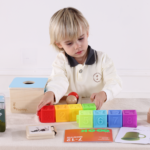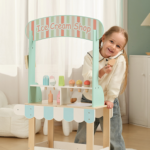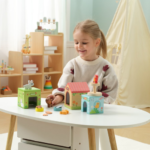“The more passive the toy, the more active the play.”
Children are naturally wired to learn, explore, discover, and create. Their growing minds are designed to test ideas, seek solutions, and experiment through trial and error. They crave play opportunities that allow their imagination to run wild—and open-ended wooden toys are one of the best ways to nurture this process.
These toys are gaining momentum, not only because of their developmental benefits but also due to increasing awareness of their environmental sustainability.

What Are Open-Ended Toys?
Open-ended toys are items that can be used in countless ways. They have no fixed outcome or single function—just limitless play possibilities. Examples include wooden blocks, building platforms, role play toys, loose parts, and more.
In contrast, closed-ended toys—often battery-operated—perform a specific function. A flashing, talking toy cash register, for example, may limit a child’s imagination to just playing “shop.” But if a child builds a register using blocks and wooden planks, those same materials could later become a spaceship, a bridge, or a castle. The possibilities are endless.

Why Are Open-Ended Wooden Toys Ideal?
The magic of open-ended toys lies in their versatility. With just a few carefully selected pieces, children can create rich play worlds—meaning less clutter and fewer toys are needed overall.
They also offer significant developmental advantages:
Encourage proactive play—children lead the play instead of reacting to flashing lights or scripted voices.
Inspire creativity and innovation—kids make decisions and solve problems as they build their play scenarios.
Support lifelike role play—children can mirror and process the world around them in imaginative ways.
Most importantly, these toys don’t do the work for the child—they invite the child to think, experiment, and grow.

How Does Open-Ended Play Help Children?
Open-ended play is low-pressure, high-reward.
There’s no right or wrong way to play, which:
Frees children from performance anxiety
Sparks imagination and self-expression
Builds decision-making and problem-solving skills
Helps develop forward planning and creative thinking
Children gain valuable skills unconsciously, through play that’s engaging and enjoyable. This foundation helps them later in life, especially in tasks that require independence, critical thinking, and resilience.

How Can You Promote Open-Ended Play?
If your child is new to open-ended toys, start with “invitations to play”—small setups that prompt imagination. For example:
Create a “cake” using a wooden rainbow and building planks
Offer loose parts in a basket for decoration
Ask open-ended questions like, “What else do we need for the party?”
Eventually, your child will start directing the play. Even simple prompts like “Let’s make a shop!” can ignite ideas. Ask, “How can we build a cash register?” or “What does our shop sell?” to keep the creativity flowing.
Once children are comfortable, you’ll find they no longer need prompts—they’ll begin to create independently and enthusiastically.

What About Older Children New to Open-Ended Toys?
Older kids used to screens or battery-operated toys may resist open-ended play at first. These toys give instant rewards, so the slower, more thoughtful process of self-directed play can feel unfamiliar.
But there’s hope! Our brains are adaptable.
Think of open-ended play like building a muscle—with time, children grow more confident in making decisions and driving their own play. Even older children can benefit enormously from open-ended toys, developing enhanced creativity, focus, and cognitive flexibility.

What Open-Ended Wooden Toys Should You Start With?
Start by exploring what you already have. Children love collecting rocks, pinecones, sticks, and other natural loose parts. These are perfect open-ended resources that don’t cost a thing.
Then, consider investing in high-quality toys that are durable and versatile. Here are some essentials:
Wooden Blocks
Building Platforms
Role Play Wooden Toys
Loose Parts – Mandala pieces, buttons, stones, etc.
Small Balls – Ideal for marble runs or imaginative games
Vehicles – Nondescript ones that can be anything
Climbing Frames
Plain Roads – Without pre-printed lines or colors
You’ll be amazed at how many ordinary items can spark extraordinary creativity.

In Summary:
Open-ended wooden toys don’t just entertain—they build brains. They cultivate independence, creativity, critical thinking, and joy in play. And with fewer toys needed, your play space becomes less cluttered while your child’s mind becomes more expansive.
The earlier you start, the sooner your child will gain the lifelong benefits of open-ended, imaginative play!










